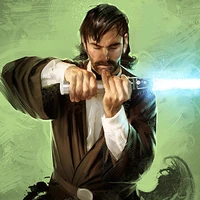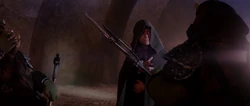| | |
Nothing is impossible with the Force.Kreia

Force powers were the manifestations of a Force-sensitive being's connection with the Force, an energy field that surrounded and bound together everything in existence. The nature and practice of such abilities were usually taught to learners by experienced practitioners, such as the Jedi and the Sith. Some techniques required a deep connection with either the light side or the dark side of the Force, but many were not specific to either affinity. The Force was practiced as a form of magic by some groups, such as the Witches of Dathomir, Nightsisters, Mind-witches, and users of Sith magic and Sith alchemy. Force powers can also be used to levitate objects, calm animals, and sense others' feelings.
Description
Overview
The Force expressed itself as the Living Force and the Unifying Force. While the Unifying Force was vast and cosmic, part of space and time rather than physical bodies, the Living Force was close to beings in their lives and deaths. Tangible Force abilities—such as soothing others' emotions, moving objects, heightening the senses, jumping, and running—were techniques related to the Living Force.[2]
The Jedi Order
A Jedi uses the Force for knowledge and defense, never for attack.Former Grand Master Yoda

The Jedi Order classified abilities with the Force according to three themes: Control, Sense, and Alter. Jedi Initiates studied Control, which was centered in one's own body and regarded as the basic skills used throughout a being's lifetime. Padawans progressed to Sense, extending themselves into their surrounding environment and expanding their awareness of the Living Force. As Jedi Knights, their education was furthered with Alter, the abilities that physically impacted their surroundings and were the most difficult to master.[2]
The Sith
A Sith knows when to unleash the fury of the dark side, and when to hold back. Patience can be a weapon if you know how to use it, and your anger can fuel the dark side if you learn how to control it.Darth Bane

The Sith Purebloods developed ritual methods of manipulating the dark side of the Force through incantations and gestures; the techniques were later adopted by the exiled Dark Jedi on Korriban and the Order of the Sith Lords. A Sith sorcerer's spellcasting techniques could be enhanced by the use of specific amulets or raiments.[5]
The Sith of Darth Bane's legacy divided their powers into three schools or focuses that channeled the dark side: Offense, Body, and Mind. Offense included skills that were dynamic, immediately applicable to lightsaber combat, and required relatively little exertion to deploy. Body drew upon the Living Force in one's own cells to affect another's on the physical plane; as such, it could damage one's body and be hindered by the presence of cybernetics. Mind, which drew upon the Unifying Force, operated in memory and thought rather than the body or physical strength; its disciplines demanded intense concentration and psychic clarity.[5]
Applications
By the Jedi Order
Control
Control is internal. It is the Jedi's ability to recognize the Force in himself and to use it to his benefit.Jedi Master Bodo Baas

The Jedi Order's teaching method began with the aspect of Control, taught to Jedi Initiates as a way to open their minds to the Force and establish a base point for further development. Control was centered on the Initiate's own body and self. Development of these skills would continue throughout a Jedi's life and serve as the foundation for subsequent disciplines.[2]
Three main abilities were centered around Control: tutaminis (energy absorption), curato salva (healing one's own self), and altus sopor (increasing one's focus on the Force).[2]
Sense
…Sense involves the next step, in which the Jedi recognizes the Force in the universe outside herself.Jedi Master Bodo Baas
The Sense discipline was taught to Padawans to broaden the scope of their Control abilities. Dipping into a deeper understanding of the Living Force, Sense abilities allowed Force-wielders to immerse themselves in the environment. By the end of their apprenticeship, Padawans were expected to use the Force as an additional sense and be constantly attuned to its undulations.[2]
The Jedi Order divided Sense abilities into four main groups: prima vitae (life detection), tactus otium (Sense Force), tai vordrax (postcognition), and projected telepathy. While there were many other styles to the Sense family, these were considered the most vital to Jedi teachings.[2]
Alter
Alter is the third and most difficult area to master, for it involves the student's ability to modify the Force and redistribute its energies.Jedi Master Bodo Baas

The Jedi Order regarded the Alter discipline as an advanced form of Force use, taught to Jedi Knights who had mastered the arts of Control and Sense. It involved manipulating objects, influencing other beings, and affecting the environment. Such abilities needed to be perfected and honed, but many non-trained Force-sensitives stumbled upon such powers accidentally, which usually resulted in disastrous events. Without advancing to the Alter discipline, individuals could see the Force, but were incapable of manipulating it.[2]
The fundamental Alter techniques were: telekinesis, affect mind, and Alter Environment.[2]
Jedi career paths
Jedi Knights and Jedi Masters pursued different careers within the Order based on their innate abilities, including their use of Force powers.[2] Jedi Consulars emphasized the more cerebral Force skills[7] and tended to utilize those powers rather than their lightsabers. Precognition and postcognition, healing, and strong empathic talents were among their specialties. Jedi Guardians often used the Force to enhance their physical capabilities, such as their reaction speed and battle awareness, but they were better known for their talents with lightsabers. Jedi Sentinels, as described by Jedi recruiter Morrit Ch'gally, struck a balance between the Guardians and the Consulars and also developed more practical abilities that did not rely upon the Force; however, some had an intuitive understanding of machinery and technology through mechu-deru.[2]
By the Sith
Offense
Offense encompasses the Force skills with immediate, dynamic applications for lightsaber combat.Darth Bane, in Book of Sith
In Darth Bane's teachings, the school or focus called Offense included immediately applicable techniques that required little exertion, making them particularly useful in lightsaber duels. Such skills included Inertia, Blind, Push, Choke, and Throw.[5]
Body
The second school, or focus, Body, encompasses those abilities that draw from the living Force. They emanate from your own cells and affect the physical structures of others.Darth Bane, in Book of Sith
Another of Bane's teachings, Body drew from the living Force in one's own cells to physically affect another being, at the possible cost of damaging the user's own body. Body techniques included lightning, convection, cryokinesis, drain life, and death field.[5]
Mind
The third school, or focus, Mind, encompasses those abilities that draw from the unifying Force. These operate on a different plane than the physical—they exist in the realm of thought and memory.Darth Bane, in Book of Sith
The last of Bane's focuses or schools was Mind, drawing upon the unifying Force to act upon thought and memory instead of the physical realm of the body. Unlike Offense, intense concentration and psychic strength were demanded by abilities such as Crucitorn, Hatred, Horror, Memory Walk, and Mind Shard[5]
Sith magic
It is not sufficient to simply use Force powers, as the Jedi teach. Ritual gives spellcasting added power.Sorzus Syn, journal excerpt in Book of Sith
The incantations of Sith magic were originated by the Sith species. They included Sutta Chwituskak (Bolt of Hatred), Odojinya (Dark Side Web), Qâzoi Kyantuska (Suppress Thought), Dwomutsiqsa (Summon Demon), and Tsaiwinokka Hoyakut (Reanimated Dead).[5]
Relativists and the Potentium
Following an alternative philosophy regarding the Force, relativists argued that the dark side did not exist within the Force itself. They believed darkness was instead a manifestation of the individual Force-wielder's mind; since darkness was relative to the purity of their intentions, the use of dark side powers was justified if their intent was pure.[2] The Potentium philosophy and those who followed it held such beliefs, which both the Jedi Order[6] and the Sith regarded as a misguided and inaccurate view of the Force.[8] The name of the theory was also used by a group founded in 132 BBY by Leor Hal, who was expelled from the Jedi Order. Hal and his disciples taught that the Force, which they also called the Potentium, was inherently and inevitably good and without a dark side, and a being's connection with it should not be obscured through training or discipline.[6]
Behind the scenes

West End Games originally established the Control, Sense, and Alter split for roleplaying game purposes in the first edition of Star Wars: The Roleplaying Game. As game mechanic, they functioned as three Force skills that a player character could train through skill points; without training, the skills could not be used. Force powers were methods of using one or more Force skills, with each power requiring a skill roll to determine its success or failure. For instance, "Contort/Escape" was a power governed by the Control skill, while "Projective Telepathy" required both Control and Sense. The rulebook emphasized that a power was not a "spell."[9]
The 2007 Star Wars Roleplaying Game Saga Edition Core Rulebook from Wizards of the Coast instead had a single Use the Force skill with Force Sensitivity and Force Training feats; Force powers were governed by Use the Force skill checks. Alter, Control, and Sense became Force talent trees rather than skills, alongside another talent tree for characters with Power of the Dark Side.[10] The reference book Jedi vs. Sith: The Essential Guide to the Force, written by Ryder Windham and published by Del Rey on November 27, 2007,[11] canonized the names Control, Sense, and Alter as in-universe descriptions used to classify various uses of the Force rather than purely game mechanics.[6]
Appearances
- ° Star Wars: Tales of the Jedi (comic series)
- Knights of the Old Republic 4
- Star Wars: Knights of the Old Republic
- Star Wars: Knights of the Old Republic II: The Sith Lords
-
 "Return" on The Old Republic's official website (article) (backup link)
"Return" on The Old Republic's official website (article) (backup link) - Star Wars: The Old Republic
- Star Wars: The Old Republic: Rise of the Hutt Cartel
- Star Wars: The Old Republic: Shadow of Revan
- Star Wars: The Old Republic: Knights of the Fallen Empire
- Star Wars: The Old Republic: Knights of the Eternal Throne
- Star Wars: The Old Republic: Legacy of the Sith
-
 "Disorder" on The Old Republic's official website (article) (backup link)
"Disorder" on The Old Republic's official website (article) (backup link) - Darth Bane: Path of Destruction (and audiobook)
- Darth Bane: Rule of Two (and audiobook)
- Darth Bane: Dynasty of Evil (and audiobook)
- Darth Plagueis (and audiobook)
- Star Wars: Episode I The Phantom Menace
- Star Wars: Episode II Attack of the Clones
-
 Star Wars: Clone Wars — "Chapter 6"
Star Wars: Clone Wars — "Chapter 6" -
 Star Wars: Clone Wars — "Chapter 7"
Star Wars: Clone Wars — "Chapter 7" - Star Wars: The Clone Wars film
-
 Star Wars: The Clone Wars — "Ambush"
Star Wars: The Clone Wars — "Ambush" - Star Wars: Episode III Revenge of the Sith
-
 "The Final Exit" — Star Wars Adventure Journal 4 (also reprinted in The Best of the Star Wars Adventure Journal, Issues 1-4; Tales from the Empire; and Classic Adventures: Volume Four — The Best of the Journal)
"The Final Exit" — Star Wars Adventure Journal 4 (also reprinted in The Best of the Star Wars Adventure Journal, Issues 1-4; Tales from the Empire; and Classic Adventures: Volume Four — The Best of the Journal) - Star Wars: The Force Unleashed
-
 "The Heart of the Universe" — Star Wars Gamemaster Screen
"The Heart of the Universe" — Star Wars Gamemaster Screen - Star Wars: The Force Unleashed II
- Star Wars: Empire at War
- Star Wars: Empire at War: Forces of Corruption
- Jedi Dawn
- Star Wars: Episode IV A New Hope (First appearance)
-
 "To Fight Another Day" — Star Wars Adventure Journal 6 (also reprinted in Hyperspace: The Official Star Wars Fan Club)
"To Fight Another Day" — Star Wars Adventure Journal 6 (also reprinted in Hyperspace: The Official Star Wars Fan Club) -
 "The Most Dangerous Foe" — Star Wars Adventure Journal 11 (also reprinted in Hyperspace: The Official Star Wars Fan Club) (In flashback(s))
"The Most Dangerous Foe" — Star Wars Adventure Journal 11 (also reprinted in Hyperspace: The Official Star Wars Fan Club) (In flashback(s)) -
 "Only Droids Serve the Maker" — Star Wars Adventure Journal 10 (also reprinted in Hyperspace: The Official Star Wars Fan Club)
"Only Droids Serve the Maker" — Star Wars Adventure Journal 10 (also reprinted in Hyperspace: The Official Star Wars Fan Club) - Introductory Adventure Game
-
 "Uhl Eharl Khoehng" — Star Wars Adventure Journal 8 (also reprinted in Hyperspace: The Official Star Wars Fan Club)
"Uhl Eharl Khoehng" — Star Wars Adventure Journal 8 (also reprinted in Hyperspace: The Official Star Wars Fan Club) - Domain of Evil (also reprinted in Classic Adventures: Volume Two)
- Operation: Elrood
-
 "The Breath of Gelgelar" — Star Wars Adventure Journal 14 (also reprinted in Hyperspace: The Official Star Wars Fan Club)
"The Breath of Gelgelar" — Star Wars Adventure Journal 14 (also reprinted in Hyperspace: The Official Star Wars Fan Club) - The Jewel of Yavin
- The Bounty Hunter
-
 "Idol Intentions" — Star Wars Adventure Journal 12 (Mentioned only)
"Idol Intentions" — Star Wars Adventure Journal 12 (Mentioned only) - Battle for the Golden Sun
- Star Wars: Episode V The Empire Strikes Back
-
 "Blood Inheritance" — Tapani Sector Instant Adventures
"Blood Inheritance" — Tapani Sector Instant Adventures - Star Wars: Shadows of the Empire Ertl minicomic (Mentioned only)
- Star Wars: Episode VI Return of the Jedi
- Star Wars: Return of the Jedi novelization (and unabridged audiobook)
- Star Wars: Episode VI Return of the Jedi junior novelization
-
 "Escape from Balis-Baurgh" — Star Wars Adventure Journal 1 (also reprinted in Hyperspace: The Official Star Wars Fan Club)
"Escape from Balis-Baurgh" — Star Wars Adventure Journal 1 (also reprinted in Hyperspace: The Official Star Wars Fan Club) - X-Wing Rogue Squadron 16 (In flashback(s))
- X-Wing Rogue Squadron 17
- X-Wing Rogue Squadron 18
- X-Wing Rogue Squadron 19
- X-Wing Rogue Squadron 20
- Star Wars: Jedi Knight: Dark Forces II
-
 "The Prize: A Scout Adventure" — Galaxy Guide 8: Scouts
"The Prize: A Scout Adventure" — Galaxy Guide 8: Scouts -
 "Endgame" — Endgame (Reprinted and collected in The DarkStryder Campaign, Deluxe)
"Endgame" — Endgame (Reprinted and collected in The DarkStryder Campaign, Deluxe) - Heir to the Empire (and unabridged audiobook)
- ° Star Wars: Heir to the Empire
- Dark Force Rising (and unabridged audiobook)
- ° Star Wars: Dark Force Rising
- The Last Command (and unabridged audiobook)
- ° Star Wars: The Last Command
-
 "Relic" — Star Wars Adventure Journal 6 (also reprinted in Classic Adventures: Volume Four — The Best of the Journal)
"Relic" — Star Wars Adventure Journal 6 (also reprinted in Classic Adventures: Volume Four — The Best of the Journal) -
 "Rendezvous with Destiny" — Star Wars Adventure Journal 6 (also reprinted in Hyperspace: The Official Star Wars Fan Club)
"Rendezvous with Destiny" — Star Wars Adventure Journal 6 (also reprinted in Hyperspace: The Official Star Wars Fan Club) -
 "Betrayal by Knight" — Star Wars Adventure Journal 12 (also reprinted in Hyperspace: The Official Star Wars Fan Club)
"Betrayal by Knight" — Star Wars Adventure Journal 12 (also reprinted in Hyperspace: The Official Star Wars Fan Club) - Dark Empire 1
- Dark Empire 2
- Dark Empire 3
- Dark Empire 4
- Dark Empire 5
- Dark Empire 6
- Star Wars: Jedi Knight: Mysteries of the Sith
- Dark Empire II 1
- Dark Empire II 2
- Dark Empire II 3
- Dark Empire II 4
- Dark Empire II 5
- Dark Empire II 6
- Empire's End 1
- Empire's End 2
- Jedi Search
- Dark Apprentice
- Champions of the Force
- I, Jedi (and unabridged audiobook)
- Children of the Jedi
- Star Wars: Jedi Knight II: Jedi Outcast
- Darksaber
- Planet of Twilight
- The Crystal Star
- Star Wars: Jedi Knight: Jedi Academy
- Before the Storm
Non-canon appearances
- Star Wars Episode VII: Shadows of the Sith (Canceled)
Sources
- Star Wars Word Puzzles (Indirect mention only)
- A Guide to the Star Wars Universe (The Force)
- Star Wars: The Roleplaying Game
- Star Wars Miniatures Battles, First Edition
- Star Wars Gamemaster Kit
- Heir to the Empire Sourcebook
- Star Wars: The Roleplaying Game, Second Edition
- Dark Force Rising Sourcebook
- Galaxy Guide 9: Fragments from the Rim
- Dark Empire Sourcebook
- Planets of the Galaxy, Volume Three
- The Movie Trilogy Sourcebook
- Star Wars Miniatures Battles, Second Edition
- The Last Command Sourcebook
- Star Wars Miniatures Battles Companion
- The Star Wars Sourcebook, Second Edition
- Imperial Sourcebook, Second Edition
- The Star Wars Planets Collection
-
 "Stand and Deliver" — Star Wars Adventure Journal 5
"Stand and Deliver" — Star Wars Adventure Journal 5 -
 "Smugglers of the Outer Rim" — Star Wars Adventure Journal 5
"Smugglers of the Outer Rim" — Star Wars Adventure Journal 5 - Platt's Starport Guide
- Classic Campaigns
- Galaxy Guide 1: A New Hope, Second Edition
- Star Wars Gamemaster Screen, Revised
-
 Star Wars Customizable Card Game — Premiere Limited (Card: Affect Mind) (backup link)
Star Wars Customizable Card Game — Premiere Limited (Card: Affect Mind) (backup link) - Galaxy Guide 5: Return of the Jedi, Second Edition
- The Truce at Bakura Sourcebook
- The Essential Guide to Vehicles and Vessels
- The Thrawn Trilogy Sourcebook
- The Jedi Academy Sourcebook
- The Secrets of Star Wars: Shadows of the Empire
- Shadows of the Empire Sourcebook
- Live-Action Adventures
- Star Wars: The Roleplaying Game, Second Edition, Revised and Expanded
-
1996 Topps Star Wars: Shadows of the Empire (Card: Vader Senses His Son) (backup link)
- Shadows of the Empire Planets Guide
- Endgame
- Tales of the Jedi Companion
- Gamemaster Toolkit: Live-Action Adventures
- Galaxy Guide 3: The Empire Strikes Back, Second Edition
-
 Star Wars Customizable Card Game — Dagobah Limited (Card: Control (Light)) (backup link)
Star Wars Customizable Card Game — Dagobah Limited (Card: Control (Light)) (backup link) - Wretched Hives of Scum & Villainy
-
 "Alien Encounters" — Star Wars Adventure Journal 13
"Alien Encounters" — Star Wars Adventure Journal 13 -
 "Scouts' Dispatch" — Star Wars Adventure Journal 13
"Scouts' Dispatch" — Star Wars Adventure Journal 13 - Lords of the Expanse
- Cracken's Threat Dossier
- Star Wars Trilogy Sourcebook, Special Edition
-
 "Tasariq: The Crystal Planet" — Star Wars Adventure Journal 15
"Tasariq: The Crystal Planet" — Star Wars Adventure Journal 15 - Alien Encounters
- Star Wars Handbook 1: X-Wing Rogue Squadron
- Star Wars: The Visual Dictionary
- Star Wars Roleplaying Game Core Rulebook
-
 "The Anzati" — Star Wars Gamer 1
"The Anzati" — Star Wars Gamer 1 -
 "Quinlan Vos: Jedi Without a Past" on Wizards.com (content now obsolete; backup link)
"Quinlan Vos: Jedi Without a Past" on Wizards.com (content now obsolete; backup link) - The Dark Side Sourcebook
-
 "Rescued Aliens: Bogey and Hawk-bat" on Wizards.com (content now obsolete; backup link)
"Rescued Aliens: Bogey and Hawk-bat" on Wizards.com (content now obsolete; backup link) -
 "Dark Blue" on Wizards.com (content now obsolete; backup link)
"Dark Blue" on Wizards.com (content now obsolete; backup link) - Star Wars Roleplaying Game Revised Core Rulebook
-
 "Kyle Katarn, Jedi Outcast" on Wizards.com (content now obsolete; backup link)
"Kyle Katarn, Jedi Outcast" on Wizards.com (content now obsolete; backup link) -
 "Mood Swings" on Wizards.com (content now obsolete; backup link)
"Mood Swings" on Wizards.com (content now obsolete; backup link) - Power of the Jedi Sourcebook
-
 "Tru Veld, Jedi Padawan" on Wizards.com (content now obsolete; backup link)
"Tru Veld, Jedi Padawan" on Wizards.com (content now obsolete; backup link) -
 "Komari Vosa" on Wizards.com (content now obsolete; backup link)
"Komari Vosa" on Wizards.com (content now obsolete; backup link) -
 "Vergere, Master of Mystery" on Wizards.com (content now obsolete; backup link)
"Vergere, Master of Mystery" on Wizards.com (content now obsolete; backup link) - Ultimate Alien Anthology
- Star Wars: Knights of the Old Republic: Prima's Official Strategy Guide
-
 "Aargau: For All Your Banking Needs" on Wizards.com (content now obsolete; backup link)
"Aargau: For All Your Banking Needs" on Wizards.com (content now obsolete; backup link) -
 "T'ra Saa" on Wizards.com (content now obsolete; backup link)
"T'ra Saa" on Wizards.com (content now obsolete; backup link) -
 "Lorian Nod" on Wizards.com (content now obsolete; backup link)
"Lorian Nod" on Wizards.com (content now obsolete; backup link) -
 "Darth Malak" on Wizards.com (content now obsolete; backup link)
"Darth Malak" on Wizards.com (content now obsolete; backup link) - Star Wars: Knights of the Old Republic II: The Sith Lords: Prima Official Game Guide
-
 "We Don't Need That Scum" on Wizards.com (content now obsolete; backup link)
"We Don't Need That Scum" on Wizards.com (content now obsolete; backup link) -
 "Revenge of the Sith Preview 9" on Wizards.com (content now obsolete; backup link)
"Revenge of the Sith Preview 9" on Wizards.com (content now obsolete; backup link) -
 "Heroes of Revenge of the Sith" on Wizards.com (content now obsolete; backup link)
"Heroes of Revenge of the Sith" on Wizards.com (content now obsolete; backup link) -
 "Universe Preview 9" on Wizards.com (content now obsolete; backup link)
"Universe Preview 9" on Wizards.com (content now obsolete; backup link) -
 "Universe Preview 10" on Wizards.com (content now obsolete; backup link)
"Universe Preview 10" on Wizards.com (content now obsolete; backup link) - Jedi vs. Sith: The Essential Guide to the Force
- Fate of the Jedi: Dramatis Personae
-
 "Power Beyond Belief" on Wizards.com (content now obsolete; backup link)
"Power Beyond Belief" on Wizards.com (content now obsolete; backup link) - The Force Unleashed Campaign Guide
-
 "Planet Hoppers: Phindar" on Wizards.com (content now obsolete; backup link)
"Planet Hoppers: Phindar" on Wizards.com (content now obsolete; backup link) - The Complete Star Wars Encyclopedia
- The Clone Wars Campaign Guide
-
 "Fringe Stat Pack" on Wizards.com (content now obsolete; backup link)
"Fringe Stat Pack" on Wizards.com (content now obsolete; backup link) - The Jedi Path: A Manual for Students of the Force
-
 "Secrets of the Force" — Star Wars Insider 123 (also reprinted in Special Edition 2013 and The Best of Star Wars Insider Volume 3)
"Secrets of the Force" — Star Wars Insider 123 (also reprinted in Special Edition 2013 and The Best of Star Wars Insider Volume 3) - Star Wars: The Old Republic Explorer's Guide
- Book of Sith: Secrets from the Dark Side
- Star Wars: The Ultimate Visual Guide: Updated and Expanded
- Star Wars: The Old Republic Encyclopedia
- Star Wars: Edge of the Empire Core Rulebook
-
 Star Wars: Force Collection (Card: Zuckuss (★★★★)) (Indirect mention only)
Star Wars: Force Collection (Card: Zuckuss (★★★★)) (Indirect mention only) - Star Wars: Age of Rebellion Core Rulebook
- Keeping the Peace
Notes and references
- ↑ Star Wars: Knights of the Old Republic II: The Sith Lords
- ↑ 2.00 2.01 2.02 2.03 2.04 2.05 2.06 2.07 2.08 2.09 2.10 The Jedi Path: A Manual for Students of the Force
- ↑ Star Wars: Episode V The Empire Strikes Back
- ↑ Darth Bane: Rule of Two
- ↑ 5.0 5.1 5.2 5.3 5.4 5.5 5.6 5.7 5.8 5.9 Book of Sith: Secrets from the Dark Side
- ↑ 6.0 6.1 6.2 6.3 6.4 6.5 Jedi vs. Sith: The Essential Guide to the Force
- ↑ Knights of the Old Republic 4
- ↑ Darth Plagueis
- ↑ Star Wars: The Roleplaying Game
- ↑ Star Wars Roleplaying Game Saga Edition Core Rulebook
- ↑
Jedi vs. Sith: Star Wars: The Essential Guide to the Force on Penguin Random House's official website (backup link)